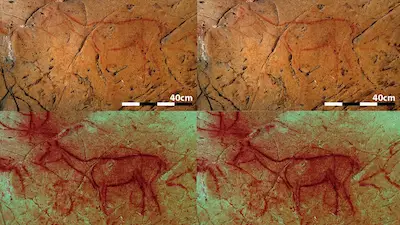|
3D Photography Reveals 'Hidden' Paleolithic Cave Animal Art
September 6, 2023 Archaeologists, perhaps channeling their childhood viewing whims, have found hidden animal figures on cave walls in Spain that date back tens of thousands of years. 
The drawings adorn the cave of La Pasiega, which is in north-central Spain, about 260 miles from Madrid. More than 700 illustrations of animals, along with dots and lines and symbols, dot the walls of the cave, which was discovered in modernity only in 1911. Dating of the art puts it at being done more than 40,000 years ago, in the Paleolithic Era. According to Complutense University of Madrid archaeologist and photographer Raquel Asiain, it was the 3D stereoscopic methods of viewing that yielded the heretofore unseen images: horses and aurochs (a now-extinct species of cow). The key was in the method: Take two high-resolution photos 2.5 inches apart and then view them together, forcing the human brain to craft a three-dimensional image. Wearing 3D glasses makes this process easier, but just crossing one's eyes can approximate the same experience. Yielding the highest resolution photos was a viewing device, similar to the View-Master, the highly popular stereoscope that premiered in the first half of the 20th Century and remains popular today. The study appears in the August 17 issue of Antiquity. |
Social Studies for Kids |
Social Studies for Kids
copyright 2002–2024
David White





